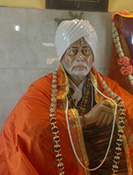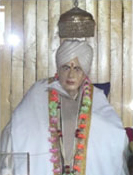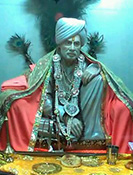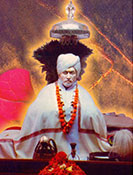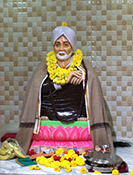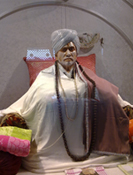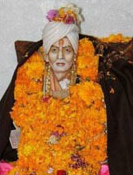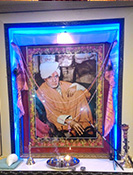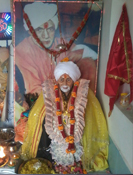Immortal Sayings of Bhagavaan Gopinath Ji Maharaj
With due reverence & humble submission at the lotus feet of Brahmadevata Shiva Swaroop Sadguru Bhagavaan Shri Gopinath Ji Maharaj & with due respect & best wishes to all the devotees of Shri Bhagavaan Ji, we present herewith the invaluable gift of Shri Bhagavaan Ji’s Amrit-Vaani (Immortal Sayings), for the benefit of all mankind. We sincerely hope that the readers will spare a few moments at reflect on the deeper meanings of each immortal saying of Shri Bhagavaan Ji & share the nectar of divine message with their respective families, friends & relatives. May the perpetual blessings of Shri Bhagavaan Ji be with us all.
Jagatguru Shri Bhagavaan Gopinath Ji Uvacha (Said): -
- Syazar; Pazar; Shvazar - One should cultivate and preserve the three virtues of righteous moral conduct, viz straightforwardness, honesty and purity in thought, word and deed.
- Even one of the 700 verses of Shrimad Bhagavad Gita can be one’s Guru – Bhagavaan Ji emphasized on Nitya-Sadhna (regular practice of introspection, contemplation & meditation for spiritual elevation), Nishkam-Sewa (Service to mankind & other creation of God without selfish motive) leading to self-perfection & social efficiency & harmony, which go very much in line with teaching of Shrimad Bhagavad Gita.
- All that exists is the reflection of God & AUM (OM) is its root. OM pervades everything, nothing is possible without it. Meditating on OM means being wholly rid of the Ego (false identity of one’s self as a perceiver, feeler, thinker, doer & enjoyer etc), only then the Self-Realization is possible.
- “Mehnat Panyein.....beyi......Guru-Kripa chhe zarori Brahmaboda baapat” – One’s own conscious efforts (purushaarath) & Guru’s grace / guidance is indispensible for God realization.
- One can realize the Self by discretion (discrimination) & accept that truth alone is life & to get established in truth is the love of God.
- “Amar.....Chhaa....Maraan”? – does immortal die? – Life & death is only for the body & not for Soul that imparts life to all the living beings irrespective of their gender. Soul is neither born, nor it dies; it is eternally existent & immortal.
- Where is the way for spiritual advancement as long as there is lust?
- It is a sure indication of God’s grace if someone surrenders at the feet of one’s Guru.
- A man or an animal with strong & fit body can swim across a river. A small insect like an ant can’t do it without help. It needs help.
- If after studying all the Vedas & Shastras, one does not act upon what he / she has gathered from those scriptures & at the same time is also bereft of the Guru’s grace, then all the study only exhausts one & it goes waste.
- A Yogi may get God realization but a Vicharwaan can get complete realization of Brahmn (God).
- He will boldly cross the ocean of Maya (illusion), who though seemingly attached to the world, has given up all the worldly desires & ambitions.
- Think of Brahmn (God) as a tree & sit on any one of its branches (representing Brahma, Vishnu/Narayana, Maheshwara etc)...the same goal will be reached at in each case.
- Ahamkar (Ego) or “I” feeling means the belief that I am the perceiver, feeler, thinker, doer & enjoyer. But the true “I” is Omkar which leads to self-realization – by meditating on OM; we will be able to realize our divine reality.
Elaborated meaning of the holy sayings:
Saying No. 1 of Shri Bhagavaan Ji Maharaj: - Syazar (straightforwardness); Pazar (honesty); Shvazar (purity) - One should cultivate and preserve the three virtues of righteous moral conduct, viz straightforwardness, honesty and purity in thought, word and deed.
Shvazar is the purity of mind, as purity is invoked in the Murti. Murti according to the Sanatan Dharma is not an idol, nor an image. According to the Atharva Veda, it is but the living presence of the Deity, to whom we are going to associate our life principle.It is only possible, if initiated into prana / vital force or breath through the Prana Pratish Tha, under the Vedic injunctions. The Pazar is that living vibrations of a Siddha Purusha were being felt for the first time. This is whar silent gospel does through images. This is known as the creative intelligence of Pazar. Pazar is to have Time with divinity, to live with Divinity and to reveal our shortcomings with Divinity, making a promise not to do any untoward thing, if wittingly or unwittingly committed in past. This is Prayashchit, what he would do through his Ahutis and with the Prayashchit Mantra, during Havan. A Sadhaka can enter the inner chambers of the heart of Bhagavaan Ji, and listen to his gospel in silence and get it merged in the applied form of Karma, in relation to Dharma. This word of being in Pazarstate of mind has the source in the Veda, as the Sutra runs as" Satyam vadishyami. The Gospel of Bhagavaan Ji only affirms the Vedic thought and asks us to reconstruct it in our body, mind and soul.
Shvazar is the height of the self surrender, being in the state of humility>no intellectual heights can estimate the inner recesses of Bhagavaan Ji, unless it his Grace, as said in the Guru Gita Jnanam Anantam, is the thin line through which the processing of purity takes place to make an orb or a blue print on the axis, so that the equilibrium takes place in body, mind and soul.
Pazar is Sattva--a name, as well as an attribute of the Absolute Reality, termed as the Naada Brahman in the Agamas of Kashmir. Pazar is truthfulness, embedded with Kripa / mercy and marvel of the Incarnation.. It is of course, a cosmic scene resolved into the human birth. The Divine descends and roams around the people like an ordinary human being and observes minutely the happening in the world around him. With the descend of the Avatara, a specific phenomenon is witnessed by all, but only a few devotees have some intuitive faculty to recognize that embodied soul wandering here and there to reveal, what "Pazar ' means in the world around him ,in that specific period of time. With his appearance on that Bhava Lila also known as the cosmic drama, which of course becomes very sublime in nature, the Avatar does not shows indifferent attitude to life, but a Siddha Purusha does show the indifference to the worldly life .That indifference makes his thinking flowered with Upasana. He looks different, acts differently, behaves differently and is not attached to the world. He needs some helpers--say his spiritual associates to help him in recognizing his heights of spirituality.
Devi Sharika's Avatiirna in the the Sharika Mahatamyam takes place for the redeeming thoughts of Shakti Paata, then. Devi in the Shila with श Sha Varnamala is the Divine vibration, which would be whispered through the lips of Bhagavaan Ji at Shri Sharikas Devi Angan at Hari Parbat. That whisper is the vibration of the Gospel. Though it is subtle but audible to the devotees ear and visible to the Upasakas eye. It is Mantra Ruupini Shakti.
Bab Bhagavaan Ji opens before us the mystery of birth and death, sacrifice and adoration, in his day today Kartavya / formal duties of a Grihasthi Sant. His saying would be to go through the furnace of Dhyana and Stutui---a spiritual way, what successive generations of believers have striven to follow. A vivid Lila of Bhagavaan Ji is seen by the believers, and spiritually evolved people considering him a saviour of the era. Not only in India, but in other parts of the world, the 21st century affirms that the photographs of Bab Bhagavaan Ji is being adored, who virtually do not know what the Sanatana Dharma is, or what Bhagavaan Ji looks like. Those people, who just hear the name, derive there from the moral code of life, spiritual atmosphere, intellectual creativity and gnostic characteristics of Bhakti / devotion, as has been said in the Bhakti Sutras of Narada.
Bab Bhagavaan Ji shows what life is and makes us learn to derive the message from the Karma Yoga of the Bhagwadgita, which is Pazar in real sense of the term. This is the Siddhaanta --a sspiritual principle of the Parma Satya, which in Kashmiri language is Pazar, woven with the thread of being in the Sthita Prajnya state of mind. By living with Bhagavaan Ji is really an Agni Pariksha--to come out all with glittetering colours in the true nature of Mata Sita of the Ramayana, Agni Pariiksha , I think can be taken as the processing of the gold in the fire for ornamentation of the spiritual self. Fire or Agni is one among the Pancha Tattvas, which is the very breath of Mahadeva. The Sadhana like Hanumana is to serve him in his life time in his Ashram like home at Gadood Bagh, Breyi Kujan, Srinagar, and to listen to him is like Vibhishana's Punya Karma. His Sezar is woven in the Ramayana Mahagrantha.
But what about those who were born after his Nirvana? We need not to be agnostic under such situation. I narrate my understanding about Bab Bhagavaan Ji, when I was around 37 year old. I heard of Bab Bhagavaan Ji in the year1978, for the first time, when Shri Omkar Nath Chrangoo, a friend of mine advised me to pay my obeisance to Bab Bhagavaan Ji at Kharyar shrine. Then I would go there off and on, to listen to the Bhajans sung by the elderly as well some adults. The Murti of Bab Bhagavaan Ji appeared to me a living personification of Pazar, as I observed the highest form of living presence in that Murti. Very honestly, I say that I had never heard of Bhagavaan Ji till that period and I was one of the persons in that close vicinity not to have his Darshana in his life time. Perhaps, Bab Ji wanted me to understand him after his Maha Prayaan, I wonder, how I am being asked to write the one of the sections of the Gospel. The credit should be given to Jaya Ji, who wrote Guru vandana Dasdhkam after general exodous, and inspired me to understand Bab Ji through devotion and not through introspection. This is the Bija Mantra of understanding Bab Ji. Shri Pran Nath Ji Kaul, had the blessings of Bab Ji, being a primal force who ignites my thoughts and makes me to reach before Bab Ji's spiritual realm through the recycling of words, that have been head by me about Bab Ji. His gospel is the open book of spirituality, take Syazar is the horizantal line to be assessed only through the heights of śvazara - purity.
Saying No. 2 of Shri Bhagavaan Ji Maharaj: - Even one of the 700 verses of Shrimad Bhagavad Gita can be one’s Guru....!!!
Yes that is right. Any holy scripture is the God himself in the form of holy words. That is the reason why the holy scripture of Sikhs is called with reverence as “Guru Granth Sahib Ji”.
The first word of Bhagavad Gita in the first verse of the first chapter is ‘Dharma’ & the last word of the last verse in the last chapter (chapter 18) is ‘Mamah’. If we read the first & the last word together, then it become “Dharma-Mamah” & if we read the words in reverse way, then it becomes “Mamah-Dharma”. In both the cases it means – “My Dharma”. What does it mean??? The word Dharma has various meanings given by various scholars from time to time. However, in the path of spiritual studies, Dharma has much deeper meaning. Dharma means the real existence or the real essential nature of something or someone. For example Sun is known by its light & heat & the same is true with fire. Water has the quality of wetting & it is neither combustible nor does it support combustion. If someone says that he has seen a cold & dark Sun & cold-dark-wetting Fire, then it would mean that the person is not talking about the Sun & Fire. Similarly if someone says that he had fallen in a pool full of drying & burning water, then we can say confidently that this person does not know what water is. Therefore the real existence of Sun & Fire is light & heat & that of water is wetting & non-combustion.
Through the holy message & guidance given in Bhagavad Gita, God clearly indicates to us about what is the real existence / real essential nature (Dharma) of a human being. Due to non apprehension of the reality about ourselves, we the human beings have become the victims of many misapprehensions, viz., we say that we are born, we grow, and we suffer due to diseases & deformities of the body, suffer the feeling of sadness of mind, become happy due to pleasures, grow old & finally die. What an unfortunate misapprehension about ourselves!!! Now the saying that any one of the verses of Bhagavad Gita can be our Guru! – God’s message is like the electricity flowing through a wire from the powerhouse to the home appliances. You touch the live wire at any place between the powerhouse to the appliance & you get a shock. Similarly if we touch any one of the verses of Bhagavad Gita, i.e., reflect & contemplate upon it with purified mind & intellect, then it can give us the shock enough to wake us up from our dreams of misapprehensions, misconceptions & superstitions etc. Thus the verse will verily act as a Guru for anyone with purified mind & intellect.
One of such live wire points / plug-points of Bhagavad Gita is the Verse 66 of Chapter 18 which has the following message: “Sarva Dharmani Pari-taejaya Maam-ekam Sharanam Vrajah! Aham Tava Sarva-papey-bhayo Mokshishyame Ma-shucha!!” Let us try to understand what God wants to tell us, teach us in this verse. Keeping in view the example of Sun, Fire & Water, mentioned above, we can very well see that we are suffering from the misapprehension about ourselves. We think that we are the body, mind, intellect shaped bundle of consciousness & we spend our lives in slavery of desires, fears, sadness, fleeting happiness (in short we keep on suffering from undetected madness due to subtle split in our personalities or multiple personality syndrome). Such a fatal condition as diagnosed by our holy scriptures including Bhagavad Gita is called Adharma (false-existence) or Pardharma (stranger’s existence). This condition brings in two most undesirable experiences which are capable enough to rip-off our personality.....those are Fear & Grief. Fear is for ‘I’ – i.e., apprehension of something untoward happening to one’s own health or life & Grief is for the sense of ‘Mine’ – i.e., loss of one’s possessions, & dear objects & person. Through the above verse 66 of chapter 18 of Shrimad Bhagavad Gita, God has offered real cure from the colossal disaster when he says, ‘Abandon all the Dharmas (of the body, mind & intellect), i.e., give up your all the false identifications with your body, mind & intellect, & take refuge in me alone, i.e., take up the endeavour of knowing your real-self. I will liberate thee from all Sins, i.e., you will get free from the darkness of ignorance & its associated desires & fears, hence Grieve-Not”. Once a person has firm faith in this divine guiding hint, then he / she will progress on inward journey to reach primordial truth. Such a person automatically has true sympathy towards fellow beings & helps them by thought (Mansa), words (Vaacha) & deeds (Karmana) without expecting anything in return. This is because such a person knows that truth (God) alone exists & by serving fellow beings means serving his own purpose. Such a person wishes that just like him other people too should get relieved from worldly stresses, strains, turmoil so that they are free to take up the endeavour of knowing their real-self, get liberated from unreal & attain unending peace & bliss. This is how Dharma-Sanasthapana (establishing of true existence) happens.
Saying No. 3 of Shri Bhagavaan Ji Maharaj: "all that exists is God & OM is its root......" Let us see how it has been explained & what is OM?
As per Vedic Scriptures: "Prajapatir-ve-Idam Agrr Aasit, Tasya Vaag Divitya Aasit, Vag-Vai Parmam Brhamam" Meaning: before the creation of everything was Prajapati (God), he had with him the divine word of power (Vaag-Divitya) & this divine word is the Param Brahmn himself. Then the Rishis have mentioned that this word (Vaag or Akhshara) is the holy syllable OM.
Similarly in the fourth gospel of the New Testament of Holy Bible is the mention: "in the beginning there was the word, this word was with God & the word itself was the God".
In the holy Guru Granth Sahib Ji is the mention of Moolmantra of Japji Sahib: "Ekomkaar Satnam Karta Purkh Nirbau Nirbair Akaalmurat Ajuni Saibung Gurprasad Jap, Adi Sach Jugad Sach Haibhi Sach, Kahe Nanak Hoosebhi Sach" Meaning: That ONE - Omkar alone is truth & revealer of truth, basis of existence of everything known & unknown (Karta), ancient than the concept of ancient (Purkh), it is without any fear (Nirbau) because none other than it exists, also it is without any anger hatred jealousy & animosity (Nirbair) because one can fear of something or someone other than himself, since Omkar alone exists it is devoid of any fear & aversion. Time (Kaal) is the false concept of mind as past present & future, but Omkar is ever present unendingly hence it is beyond the concept of three periods of time (Akaalmurat). This Omkar is neither the cause of any effect nor is it effect of any cause but is unborn (Ajuni). It is ever unchangeably independent & self-existent (Saibung). Knowing Omkar is the real goal & its attainment liberates one from all the ignorance (Gurprasad) - therefore remember it uninterruptedly (Jap). When nothing existed Omkar existed (Adi Sach), when it manifested in very subtle form then this Omkar alone existed (Jugad Sach), while these three worlds of gross subtle & causal, namely the worlds of wakeful consciousness, dream consciousness & dreamless deep sleep consciousness exists, this Omkar as support & substratum of all continues to exist as present moment (Haibhi Sach). Guru Nanak Ji says (Kahe Nanak) when nothing will exist then again this Omkar alone will truly exist (Hoosebhi Sach).
Also, in Srutis it is mentioned: "Om it-ek-akhshar dhyanaat Vishnur Vishnutav vaaptvaan, Brahma brahmatva-mapnah, Shivataam bhavat Shivah". Meaning: it is because of knowing the transcendental truth due to contemplation on Omkara that Vishnu has got Vishnu-padvi, Brahma got brahma-padvi & Mahadeva got Shiva-padvi. Therefore Rishis after their subjective experience of this truth have mentioned “OM Aksharam Parmam Brahmam Jyoti Rupam Sanatanam, Nirgunam Nirakaarmam Pranavakaram, Namameham”! Meaning: O’ Omkar the imperishable, Supreme God, of the form of divine light, the eternal, without attributes, giving life & flowing through Pranas (life breath & various body systems), I surrender my being unto you & merge in thy existence. This makes it clear that OM is the real existence of anything & any being.
To make it further clearer, let us take a simple example. If I am lucky to have Darshana of Bhagavaan Shri Gopinath Ji, or Shri Ram Ji, or Shri Krishana Ji, or Dev-adi-dev Mahadev Ji, or Mata Durga etc in my dream & by chance if I happen to get this divine experience again & again & may be also when I am awake. Then I will think that I am the luckiest person & get pampered enough to think myself as a saint. Also when someone among my family, relation or friend circle will come to know about it, I will be swarmed by people to have my darshana & ask me to present their various requests before the God, since I have darshana & meet the divinity off & on!!!
There is an interesting story of a very thoughtful & meaningful dialogue between Shri Hanuman Ji & Bhagavaan Shri Ram Ji. Before we hear the story about what transpired between the two great divine incarnates, we must consider that Shri Hanuman Ji is undoubtedly known as Parambhakta (great devotee & lover) of Shri Ram Ji who was always at the service of his beloved Shri Ram Ji, stood by him through all the thick-n-thin, besides that Shri Hanuman Ji had all the possible Shaktis & Siddhis right from his childhood & more after he met Shri Ram Ji & Shri Hanuman Ji is also called as Ekadash Rudra (11th divine projection of Mahadev Ji). Now the story goes: Once with due submission & reverence Shri Hanuman Ji asked Bhagavaan Shri Ram Ji – tell me O, my Prabhu how can I recognize you, I am unable to understand despite of being with you for such a long time! If a common person like us would hear this question, we won’t appreciate its real meaning & say Oh my God what is the question, does he not know that Shri Ram Ji is Dasharath Nandan, Ayodhya Pati, Rughukul Bushan, Sita-Pati etc & moreover Shri Hanuman Ji’s own master & closest friend? Also Shri Hanuman Ji did not see a photograph or a Statue of Shri Ram Ji in a Temple or an Ashram which filled his heart with devotion, but was personally in close communion with Shri Ram Ji at every moment. Then what was the meaning of Shri Hanuman Ji’s question in real sense? The real meaning of the question was “Hey Shri Ram Ji, tell me please how you attained to God realization (Self-Realization), got free from unreal & become one with the Paramatman? Hearing this question from his ardent devotee & keeping in mind Loka-kalyan (service to all) & Dharma-sansthapana (establishing the real existence), Bhagavaan Shri Ram Ji answered with fully blessed affection. Listen my dear Shri Hanauman Ji, I refer to a shaloka (verse) in Muktikopnishad which says: “Mandukyam Ekam Kevalam Mumukshuna Vimuktaye”. Meaning: Mandukya, i.e., Mandukya Upanishad alone has the complete information which is fully capable of liberating those who are desirous of liberation (Mukti). Hey Shri Hanuman Ji I followed the same & attained to God realization, hence I recommend the same for you too. Then Shri Ram Ji also told him, hey Hanuman Ji, just in case you are not able to grasp the meaning of Mandukya Upanishad, then please undertake the study of Kathopnishad, Brahdranikya-Upanishad, Aiterya-Upanishad, Taitariya Upanishad..... thereby mentioned to Shri Hanuman Ji the names of eleven important Upanishads. Further Shri Ram Ji said to Shri Hanuman Ji that even after studying all the eleven (11) Upanishads, if he (Hanuman Ji) was not able to understand properly then he should study all the 108 Upanishads. But for me (Shri Ram Ji) Mandukya Upanishad alone is sufficient!!! Now we will wonder what is Mandukya Upanishad & what information does it contain? The name Mandukya: it is said that the holy Upanishad was presented by Mandukya Rishi after whom the Upanishad got the name. Mandukya is the Sanskrit language term which means FROG. It is said that sometimes the Sadguru-Vani is not easy to understand & for the people of ordinary or average intellect it sounds like crocking of frogs. Also all those of us who have ever seen a live Frog, will surely admit that when a frog moves from one place to another place, it does not walk or crawl or run but takes long leaps & jumps from one place to the other to reach directly from present position to another. Hence great Rishis of yore have affirmed that if anyone understands the deeper meanings given in the Mandukya Upanishad then he / she can have direct jump to the abode of Parabrahmn, bypassing all the various sadhanas, tapas etc. Out of all the 108 Upanishads this Mandukya Upanishad is the shortest one having only twelve (12) verses which can be written on one A4 size paper page, but it is profoundest of all the Upanishads & message contained in it is the soul & essence of all the religious / spiritual scriptures of the world including Vedas & Shrimad Bhagavad Gita & all. Should the devotees of Shri Bhagavaan Gopinath Ji be desirous of knowing more about Mandukya Upanishad, then in next publication we shall definitely try to do so. For now we shall mention here the pratham shaloka (1st verse) of Mandukya Upanishad which will give us clear understanding of the holy saying - 2, under discussion, of Bhagavaan Shri Gopinath Ji. Following is the Verse: Hari OM...OM Etyetad Akhsharam Idam Sarvam, Tasyopa Vyakhyanam, Bhutam, Bhavad, Bhavishyad iti, Sarvam Omkar eva, Ya-cha-anyat Trikaala Teetam, Tad-api-Omkar eva”! Meaning: Hari-OM (OM is the remover of darkness of ignorance), OM (Parabrahmn) the holy word describes verily that whatever existed in past, exists in present & will exist in future is Omkar alone. Also whatever there is beyond the three periods of time is verily Omkar only. “Therefore the importance of Mandukya Upanishad is because it gives full meaning & description of OM which after knowing subjectively, one can really know what actually God means”!
Saying No. 4 of Shri Bhagavaan Ji Maharaj: “One’s own hard work & Guru’s grace.....essential for Self-realization”.
Jagad Guru Bhagavaan Shri Adi Shankaracharya in his famous book “Vivekachoodamani” - (Crest Jewel of Discrimination) has given beautiful insights about the truth of human birth, nature & cause of bondage in unreal & the means of deliverance / liberation (Mukti) from the bondage. To understand the saying under discussion of Bhagavaan Shri Gopinath Ji, let us have look at a few invaluable jewels of wisdom gifted to the world of humanity by Shri Adi Shankaracharya.
He says:- “For all beings a human birth is difficult to obtain, more so is a person who has faith in God; rarer still is the human being having faith in God & is deeply inclined towards knowing the truth about God; higher than him is the one who does self efforts in learning the scriptures for the sake of knowing truth under the guidance of perfected preceptor (Sadguru); discrimination between the Self & not-Self, Realization, & continuing in a state of identity with Brahman – these come next in order”. According to Shri Adi Shankaracharya, this kind of Mukti (Liberation) is a result of merits (Shubha-Karmas) of Crores of Janamas (births) by an individual.
These are three things which are rare indeed & are due to the grace of God – namely, a human birth, the longing for Liberation, and the protecting care of a perfected preceptor (Sadguru). Hence the seeker of the reality of Atman should take to reasoning, after duly approaching to his / her Guru – who should be the best of the knower’s of Brahman, and an ocean of mercy, willing to guide a person who approaches him with humble submission with burning desire for liberation from unreal & knowing the real. After having approached his Guru, one should have unshakeable faith in him & follow his instructions without slightest deviation....by following this rule a seeker becomes fit to receive continuous Guru-Kripa (grace of the preceptor)”.
As regards ‘Self-Effort’ Shri Adi Shankaracharya says: “A father has got his sons & others to free him from his debts, but he has got none but himself to remove his bondage. Tiredness caused by a load on the head can be removed by others who can help him to carry his load on their heads or shoulders, but none other than one’s own self can put a stop to the discomfort & restlessness which is caused by hunger, thirst & other such physiological needs. One has to eat the food & drink water himself to relieve him from the discomforts of hunger & thirst. A sick person, who follows the advice of the physician & takes proper precautions & medicines as advised by him, gets cured from the aliment. Neither the physician himself nor the near & dear of the ailing person can take precautions & medicines on behalf of him to cure the patient from his disease”. After all it is the sick patient who has to recover from the disease, not his physician who can help him only by way of proper diagnosis of the disease & by prescribing appropriate medicines & advice a few precautions. Similarly it is the seeker of the truth who has to know the truth by getting liberated from false. Therefore the Grace of the Guru & Self-effort are equally important for the Self-realization.
Saying No. 5 of Shri Bhagavaan Ji Maharaj: “One can realize the self by discretion (discrimination)”
After having some idea already about the reality from the detailed descriptions of Shri Bhagavaan Ji’s aforesaid saying, it is not difficult to understand how important is the power of discrimination (logical understanding of the clear difference between the real & the unreal). This indispensable tool of discrimination in our holy scriptures is called & praised as “Viveka”! It is the grace of God & Sadguru if someone is blessed with ‘Viveka-Shakti’ It is extremely powerful weapon which can blast mountains of ignorance & make the spiritual path of an aspirant clear & easy.
In the recent past almost during the same period when our revered Bhagavaan Shri Gopinath Ji was present in his physical form in Kashmir, there lived a great saint in rural areas near Pune – Maharashtra. His name was Jagad Guru Shri Nisargadatta Ji Maharaj. He has laid great emphasis on becoming a true seeker of truth, i.e., to become a all in one devotee who is a Mumukshu (one who is desirous of liberation from the shackles of unreal), Jigyasu (inquisitive of knowing & following the truth) & Saadaka (who dares to undertake self-effort & self-application to get established in truth). Guru Maharaj Nisargadatta Ji says: “the seeker is he who is in search of himself. Give up all questions except one: ‘Who am I?” After all, the only fact you are sure of is that you are. The ‘I am’ is certain. The ‘I am this’ or ‘I am that’ is not. Struggle to find out what you are in reality. To know what you are, you must first investigate and know what you are not. Discover all that you are not -- body, feelings thoughts, time, space, this or that -- nothing, concrete or abstract, which you perceive can be you. The very act of perceiving shows that you are not what you perceive. The clearer you understand on the level of mind, that you can be described in negative terms only, the quicker will you come to the end of your search and realize that you are the limitless being......Jagat Guru Sri Nisargadatta Maharaj.
Let us take an example: when I am sitting in my chair in front of my computer, the objects which I perceive such as my computer, the table on which the computer is & the chair in which I am sitting – are the things which are definitely other than me. Going closer – the shirt & trousers & the undergarments which I am wearing are also the objects other than me. Now a friend of mine, who is sitting next to me working on another computer, takes a short break from the work & while sitting in his chair starts asking me amusing but thought provoking questions. Pointing towards my feet, he asks me who’s feet are those, I reply, my dear friend those are my feet, then he asks & who’s legs are those? I reply, mine, then he ascends up his eyes towards my entire body & keeps on asking me who’s body, who’s arms & who’s head is this. Every time I reply...mine....mine & mine. The matter does not finish here. Then he repeats with a different set of questions & asks me, you said that those are your feet, now tell me are you your feet, I reply NO but he keeps on asking his questions about all of my body parts & every time he asks me, I reply No...No...No. Finally he asks me, did I mean by first saying ‘Mine’ & then ‘No’ that all my body parts individually & collectively were Mine but I was not them? This time my answer was “Yes’. Therefore, after my affirmation, my friend says, ok it confirmed now that it is my body but I am not the body, hence something other than it. Then he asks me similar interesting questions about my mind & its feelings (happiness, sadness, pleasures & pains) & of my Intellect & its thoughts & ideas. I was logically compelled to accept that I wasn’t by mind & intellect either, but definitely something other than those. Again, while I had become suddenly wise & thoughtful, my friend asks me, tell me now dear that whatever good or bad, pleasant & unpleasant is happening to my body, mind & intellect, is that happening to me or to the things which are other than me. I reply – to the things other than me. Thereafter my friend recalled our discussions sometime back when I had told him that on a particular night I had darshana (vision) of Bhagavaan Shri Krishana Ji, then he asked me another question, hey was this Bhagavaan Ji myself of other than me. I replied, how can I be Bhagavaan Ji. He immediately asked me then “Who am I”? & for God’s sake do not tell me that you are son of so & so, father of so & so, husband of so & so; you are the officer & subordinate of so & so people? Please after removing all those relative identifications, I must answer precisely–“Who am I”?
Very strange but true, we know many things in life but we don’t know who we are in reality & pay no attention or interest in knowing this. This non-apprehension of the realty about ourselves gets us caught in the misapprehension about ourselves. We suffer the experience associated with unreal existence such as Birth, Growth, Diseases, Old-age & Death besides many fleeting joys & sorrows of life. The moment some blessed one knows his real-self, he / she thereafter is free from the said thraldom of life. Just like a child who was sacred to enter the dark bedroom (with lights switched off), once grown up, then the same dark room becomes a calm resting place for him / her without any fear of ghosts or red-eyed Baba.
Very famous & Great Saint of India – Sant Kabir Ji Maharaj has poured the elixir of Brahma-Jnana through his soul soothing divine poetry. Many saints & seekers have had great respect for him & consider him Guru of Guru’s. One of his famous sayings is: “Dukh Mein Sab Sumiran Karey Sukh Mein Karey Na Koi, Jo Sukh Mein Sumiran Karey Phir Dukh Kahe Hoye, Kabira.....Phir Dukh Kahe Hoye”. Meaning: Everybody remembers God when he / she is in pain, sadness or disappointed, but none remembers God when he / she is in a state of joy, is happy & delighted. If someone remembers God in his / her good times then he will never be unhappy & sad. Says Kabir thus. Now if someone who is ruthlessly intelligent, can question this statement & rightly so, that there are people who do all the pujas, charity, havan, & good deeds but still we have seen them more miserable than many other people who don’t believe in all such good deeds & pujas, prayers etc? Then the question is what the real message of Shri Kabir Ji is? Let us see: If we contemplate a bit on this immortal saying & properly introspect about the happenings in our life, we will come to know that there is something which happen to us only when we are sad & disappointed & it is at that time only we spontaneously utter something which never happens when we are enjoying our life normally or happily. This something is when we say to even to our father, mother, friend or a beloved “Please leave me alone”. We hope that most of us will appreciate that this statement – please leave me alone – comes out of us when we are not in a state of proper frame of mind, i.e., when we are sad. If we analyse this statement we can ask ourselves – for whom we want to be left-alone, to do what & what will we achieve when we are left alone? Answer is, that irrespective of whether we are aware or ignorant, there is a subtle inner voice from our Atman – O’ you human being there is no permanence or reality in this world of plurality because it may be dear to you but is perishable, therefore there is still time, turn inward towards the Atman (God within) there only is the permanent peace & solace for you, there only you are safe, that alone is your real existence, therefore leave everything aside, come to me, I will accept you & relieve you from your miseries once & forever. By the time this inner voice reaches the realms of our ignorant minds, the message gets translated by our minds to its gross meaning only. Hence Sant Shri Kabir Ji is very kind who hints us towards knowing our own real-self when our minds are not in a state of agitation, when we can spare a few moments to be really alone wilfully, when we can contemplate on the idea, that I am not the body, mind, intellect, this or that, then “who am I”? Who knows it is free from all the possible Sukha (perishable happiness) & Dukha (perishable pains). The method of contemplative, introspective, conscious & effective Meditation leading to knowing the truth of ‘who am I’ is very beautifully explained by Bhagavaan Shri Jagad Guru Adi Shankaracharya Ji in his famous “Nirvaana Shatakam” which describes the way of reaching the goal (Self-realization) by way of negation of false. In Nirvaana Shatakam the most commonly used term of negation of non-self.....‘NAMAH’ is used as ‘NAAHAM’.
Saying No. 6 of Shri Bhagavaan Ji Maharaj: “Amar.....chhaa....Maraan”? – does immortal die?
Whatever or whoever did not exist sometime back & is now seen to exist, i.e., is born, is subject to undergo changes till the time when this thing or being undergoes a permanent change, i.e., death. For example a person is born, undergoes many physiological, anatomical & psychological changes such as after birth is growth as a child, adolescent, youth, middle aged, old-aged & finally dies. During the life one suffers diseases, sometimes deformities, mental agitations & traumas. Also experiences many joys & pains, so on & so forth. These changes indicate impermanency of a being, hence falling under the category of unreal. While these changes go on, there is something as a changeless substratum which illuminates to the person all the changes that he experiences, just like on a screen of a cinema hall many scenes of movies continuously change with any change whatsoever to the screen. In the drama / movie of life the changeless screen is Atman (God), which is never born, hence there is no death for it. This idea is nicely presented in the Verse 20 of Chapter No. 2 of Shrimad Bhagavad Gita: “na jayate mriyate va kadacin, nayam bhutva bhavita va na bhuyah ajo nityah shashvato 'yam purano na hanyate hanyamane sarire” Meaning: For the soul there is neither birth nor death at any time. This has not come into being, does not come into being, and will not come into being. This is unborn, eternal, ever-existing and primeval. This does not get destroyed when the body gets destroyed.
Therefore we are guided & instructed to trust this fact & to make conscious efforts to have the subjective experience of our real-self (Atman) without any traces of misconception that we are mortal beings. If that is not true then we do human beings say after the death of a person – ‘may God rest his soul in peace’? Is it not an acceptance that the person who departed is a soul & still exists after the physical destruction (death) of the body?
Saying No. 7, 8 & 9 of Shri Bhagavaan Ji Maharaj:
- “Where is the way for spiritual advancement as long as there is lust”?
- “It is a sure indication of God’s grace if someone surrenders at the feet of one’s Guru”
- “A man or an animal with strong & fit body can swim across a river. A small insect like an ant can’t do it without help. It needs help”.
Here the reference is made to a person who does not have adequate qualities for crossing the vast ocean of ignorance & attain self-realization. It is because of his total misapprehension & ignorance about himself (his real self) which compels him to live in flesh like flesh. For such a person desire prompted actions are the only way of life, which gathers in his personality many layers of vasnas (desires) & unfortunately in fulfilling the demands of existing vasnas he is not exhausting those but make them stronger than before like pouring fuel to the fire. Lust, Anger, Greed, Pride, Jealousy, Lethargy, Illusion & Delusion becomes the earned destiny of such a person.
Then someday as a rear occurrence such a person as mentioned above after getting discontented with his life style, tired & stressed, sighing & sobbing, not finding any charm in his existing ways of his living, friends & relations & his riches, gets shattered. While this is going on in his psyche, there surfaces up a new desire (this time noble one) which prompts him to find someone who can guide him to come out of his present pathetic condition. When this desire becomes stronger in him, then the person becomes willing to surrender at the feet of a wise-man (Sadguru). This is undoubtedly the share grace of God & more so when he actually finds a true Guru who is the embodiment of God.
Once the person approaches the Guru, he can easily make out that the person is very weak to swim across the ocean of Maya (Illusion) & needs help indeed. Then because of his share affectionate & unselfish nature with full kindness, the Sadguru accepts him & prescribes him the recommended precautions & necessary dos & do-not for the emancipation of the person who is now his disciple.
On the path of spiritual realization - Sadhana Chautusht (four fold achievement) is prescribed by his Guru. First one is Viveka (power of discrimination between real & unreal). Once Viveka is established then as a natural consequence the second step called Vairagya (dispassion for unreal objects, experiences & achievements) is reached at. Once a person gets established in Vairagya the third step automatically comes forth called Mumukshutav (strong desire to get liberated from the unreal). Then the fourth step of the Sadhana Chautusht called as Shatsampati (six established abilities) become easy to attain. Those are Sama (freedom from the slavery of senses & sense objects), Dama (freedom from the mental agitations & firm control on the mind), Upriti also called as Uparma (heedless attitude towards changes within & without & no regrets), Titiksha (remarkable patience, & perseverance) which enables one to pursue the path of spirituality with steadfast efforts, Shradha (firm faith on the deceleration of the scriptures & the words of Guru having deep meanings) & finally the Samadhaan (one pointed mind & clean intellectual power without flickering & undistorted memory). After this "Samadhaan" is achieved, one is left with only question - "who am I" & then the answer come instantly from the Atman – Tat-Tavam-Asi (That Thou Art)....you are the Self within you & of the entire universe. Thus the disciple (devotee) progresses from animal-man to man-man & finally becomes God-man on earth.
Saying No. 10 of Shri Bhagavaan Ji Maharaj: “If after studying all the Vedas & Shastras, one does not act upon what he / she has gathered from those scriptures & at the same time is also bereft of the Guru’s grace, then all the study only exhausts one & it goes waste”.
This is yet another & a different case in contrast to the person who completed his journey from an animal-man through man-man & became God-man, as described above in the saying Nos. 6, 7 & 8. Jagad Guru Bhagavaan Adi Shankaracharya says in ‘Viveka Choodamani’:
“Who is a greater fool in the world, than the man who having obtained a rare human birth, neglects to achieve the real goal of this life? Let people quote the Scriptures and sacrifice to the gods, let them perform rituals and worship the deities, but there is no Liberation without the realisation of one’s identity with the Atman, no, not even in the lifetime of a hundred Brahmas put together. Therefore the man of learning should strive his best for Liberation, having renounced his desire for pleasures from external objects, duly approaching a true and generous preceptor (Guru) and fixing his mind on the truth inculcated by him”.
Saying No. 11 & 12 of Shri Bhagavaan Ji Maharaj: “A Yogi may get God realization but a Vicharwaan can get complete realization of Brahmn (God)” & “He will boldly cross the ocean of Maya (illusion), who though seemingly attached to the world, has given up all the worldly desires & ambitions”.
Here the word Yogi is not used for the real-one which means the enlightened one who’s individual soul has become one with the universal soul (God). But the reference is made here to a person who has undergone hard self-purification activities & penances for the attainment of several hidden secrets of nature which has enabled him to gain certain perfections (Siddhis). Vicharwaan is a person who with pure mind & intellect, honestly pursues the path of knowledge (Jnana) to probe into the world within & without to reach the truth (Atman). Here again is an interesting story:
King Janaka once dreamt that he was a beggar. On waking up he asked his Guru – Sage Ashtavakra: am I a king dreaming of being a beggar, or a beggar dreaming of being a king?.....because whatever I experience in my dreams appears as real a world as is the world experienced by me while I am awake. The Guru answered: You are neither, you are both. You are, and yet you are not what you think yourself to be. You are because you behave accordingly; you are not because it does not last. Anything which has a beginning & an end is changeable. Changeable means unreal. While as ‘Real’ is ever unchangeable. Can you be a king or a beggar forever? All must change. You are that which does not change? What are you? Janaka said: Yes, I am neither king nor beggar, I am the dispassionate witness. The Guru said. This is your last illusion that you are a jnani & that you are different from, and superior to, the common man. Again you identify yourself with your mind, in this case a well-behaved and in every way an exemplary mind. As long as you see even a least difference, till then you are a stranger to reality. You are on the level of the mind. When the 'I am myself' goes, the 'I am all' comes. When the 'I am all' goes, 'I am' comes. When even 'I am' goes, reality alone is and in it every 'I am' is preserved and glorified. Diversity without separateness is the Ultimate that the mind can touch. Beyond that all activity ceases, because in it all goals are reached and all purposes fulfilled.
The above said conversation was the turning point in the life of King Janaka. He became Vicharwaan & after introspecting in each experience, he totally abandoned the idea of himself being a body, mind or intellect. He reached the supreme goal of Self-realization / God-realization & lived the life as a Jeevan-Mukta (liberated while living). He did not abandon his family or his kingdom but lived totally a detached life, performing all his external duties with dispassion. His fame grew day after day to the extent that he was called as Videha (without the body). It is after his name only Mata Sita Ji got another name as Vidiehee (daughter of Videha). Even many saints & sages used to take his consent on spiritual matters.
Saying No. 13 of Shri Bhagavaan Ji Maharaj: “Think of Brahmn (God) as a tree & sit on any one of its branches (representing Brahma, Vishnu / Narayana, Maheshwara etc)...the same goal will be reached at in each case”.
After go through all the details mentioned so far it should not be difficult to understand that whatever the names be, they represent only AUM (OM). For example A represents Brahma the wakeful consciousness & Vaishvanara (Virat) aspect of GOD; U represents Vishnu (Narayana) the dream consciousness & Hirnyagarbha aspect of God & M represents Mahadeva, the deep dreamless sleep & absorption (Mahamaya) aspect of God. While the Bindu of AUM represents pure silence – the fourth state called Turiya aspect of God. This AUM contains all the names, forms & formless aspects of God, also called as Shiva & Atman. Therefore whatever name we adopt for meditation with the intention to gain Self-realization will lead us to same goal.
Saying No. 14 of Shri Bhagavaan Ji Maharaj: “Ahamkar (Ego) or “I” feeling means the belief that I am the perceiver, feeler, thnker, doer & enjoyer. But the true “I” is Omkar which leads to self-realization – by meditating on OM, we will be able to realize our divine reality”.
Now we have enough idea, from the elaborated meanings of the sayings 1 – 12 of Shri Bhagavaan Ji, about what is Ego (Ahama-Bhava) which is the cause of our birth & bondage inside the three bodies namely Sathool-Sharira (Gross Body made up of five elements), Sukshama-Sharira (Subtle Body made up of feelings of mind & thoughts of intellect) & the Kaarna-Sharira (Causal Body made up of unfulfilled desires). Transcending the three bodies means leaving Ego naked & without indulgence. Then automatically it gets absorbed in the real “I” the Atman (OM) which is our real divine existence without any further births & deaths.






